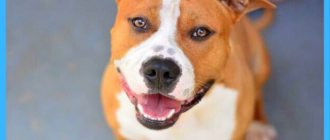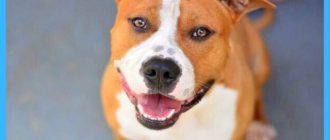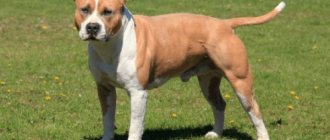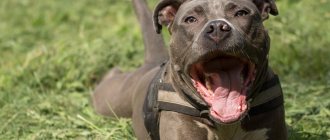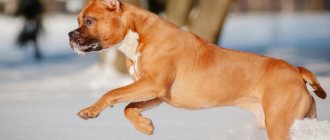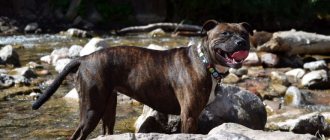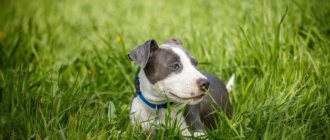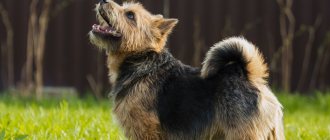| Origin: | USA (XX century) |
| Usage: | fighting, bodyguard |
| Color: | white, black, blue, brindle (solid, combined, spotted) |
| Dimensions: | height: 43-48 cm; weight: 25-30 kg |
| Lifespan: | 11-16 years old |
Amstaff is the short name for a North American species that appeared at the beginning of the 20th century. The dog's predecessors were bulldogs and game terriers. The Staffordshire Terrier appeared to the world as an excellent defender of territory; over time, individuals began to constantly participate in dog fights.
Breed standard
The American Staffordshire Terrier has a very recognizable appearance: the breed standard was approved in 1935.
The fighting breed is large in size, well built, and has a muscular build. At the same time, the Amstaff is elegant, agile and quickly reacts to what is happening around.
It’s worth immediately understanding what a Staffordshire Terrier looks like: the photos show the most common external appearance of individuals. The breed standard describes the dog as follows:
- The head of the Stafford is of medium size, the transition from the frontal zone to the muzzle is clearly visualized, the ears are located high;
- Previously, the ears of the Staffordshire Terrier were cropped; at the moment, this event is banned in most regions. In the original position, the Amstaff's ears are raised and slightly shortened. Uncropped shells cost little. If the staff's ears droop, this is considered a defect;
- Amstaff's eyes are small, round in shape, dark;
- the muzzle of the Staffordshire Terrier is distinguished by a pronounced jaw relief and a rounded nasal dorsum;
- The Amstaff Terrier has a dense build: with a muscular neck, broad shoulders, and oblique shoulder blades;
- The Amstaff's tail is set low, becomes narrower towards the end, docking is not performed;
- The breed's coat is short and shiny;
- The front legs of the Staffordshire Terrier are set wide apart and the gait is springy.
A description of the breed cannot be completed without mentioning the colors of the Staffordshire Terrier. The black shade of the Amstaff's fur is thick and rich (small marks may form on the nose and on the paws). A combination of white and black shades is possible (a light tone is noted in the area of the muzzle, neck, back and paws).
A blue dog has a nose of the same tone. The blue staff with blue-black fur boasts an almost black tip. The brindle or red Amstaff has a bright and even color with a reddish tint. There is also chocolate, grey, brown and white Stafford.
The first standard of the American Staffordshire Terrier was drawn up by W. Brandon, the future president of the Breed Club (STCA).
Origin story
The history of the American Staffordshire Terrier breed began in the 19th century in England. The ancestors of the Staff were the Old English Bulldog and Terrier. Bulldogs in those days were distinguished by their fearless fighting character and were ideally suited for bullying. Their compact, muscular body made them durable in battle, and their powerful, tenacious jaws inflicted terrible wounds. Crossing with a terrier added to these characteristics agility, mobility and a thirst for hunting. The hybrids are called bull and terriers.
In the 19th century, many countries were obsessed with the idea of dog fighting. It all started with simple baiting of rats, but the spectacle soon became boring, and the dogs were brought into the ring. Humane societies have repeatedly tried to ban fighting, but it has generated enormous income and been successful. Breeders sought to breed aggressive dogs to make fights more violent and spectacular.
In 1870, Bull and Terriers came to America; the further development of the breed remains a mystery. Most scientists have come to the conclusion that the Stafford is the result of crossing the Bull and Terrier with local species. At that time there was no generally accepted name for the breed, so foreign fighting dogs were called bulldogs and Yankee terriers, etc. Be that as it may, by the end of the 19th century, Yankee terriers began to be used as guards and housekeepers. For this reason, breeders decided to breed a larger and more resilient breed.
At the beginning of the 20th century, connoisseurs of pit bull terriers began to seek official status. They were not fans of brutal battles, so they developed external and working qualities. They managed to get a breed that looked like a pit bull, the purpose of which was not related to fighting in the ring. She was named Staffordshire Terrier. In fact, the Stafford is a show-class pit bull terrier. It gained recognition in 1936 and the breed was included in the registry of the American Kennel Club.
In 1972, the dog changed its name to the American Staffordshire Terrier, taking its rightful place in the ranks of the International Canine Federation. Amstaff was brought to Russia in 1989.
Types of amstaffs
There are three types of dogs depending on their build (body proportions, weight and height):
- Proportional amstaff. Weight of an adult dog: up to 30 kg. The body is rectangular, has the dimensions of a bulldog, the temperament of a terrier, the loin is of appropriate length, and the ideal appearance of the hind legs.
- Bulldog Amstaff. The weight of a Staffordshire Terrier of this type is more than 45 kg. The breed is distinguished by its short neck, rough build, and lack of mobility.
- Terrier Amstaff. The Stafford dog breed of this variety weighs about 30 kg. The animal has an elongated, narrow mouth and a long neck. It is characterized by an irregular angle of the glenohumeral joint.
The most valuable representatives of the breed are individuals of the first group. They lack the unattractive characteristics of their progenitor individuals and are rare.
Differences from the English Staffordshire Bull Terrier
Representatives of these breeds share common ancestors, so their similarities are absolutely not surprising.
However, there are significant differences between them:
- Amstaffs come from America, and Staffbulls were bred in England;
- English Staffordshire Terriers are more compact dogs, they are lower at the withers and weigh less;
- Amstaffs do not get along with other pets, the “English” are more tolerant and get along with animals that grew up with them.
Also, the breed standard suggests that the ears of Amstaffs can have a natural length and shape or be cropped, while for Staffbulls cropping is not carried out.
Character
Contrary to popular belief, the Amstaff is a very friendly animal towards humans. The dog is devoted to the owner and his entire family. The Staffordshire Terrier and children are a completely harmonious union. When playing with small family members, the individual is good-natured and gentle. Amstaff attacks only in case of obvious danger.
If you believe the Stafford breed standard, the Amstaff's character excludes unjustified aggression towards people - the dog is not dangerous. The breeders deliberately eliminated specimens that behaved aggressively and left exclusively human-oriented dogs.
Among the qualities inherent in the Amstaff breed are:
- courage;
- endurance;
- force;
- devotion;
- high intelligence.
Since it is logical to analyze the pros and cons of the breed, it is worth warning future dog owners that the animal does not know how to ignore the owner’s command. In this matter, the key point is the adequacy of the owner. Another disadvantage of the animal can be considered the constant need for attention from family members. Keeping such a dog on the street is a sin. Even if you build an enclosure for an animal, the dog will not be able to live there: it prefers the comfort of home.
Relationships with other animals
The Stafford dog breed is quite tolerant of other pets. This is a significant advantage, considering how many years dogs live. The characteristics of animal relationships depend on the approach of the owners.
If the pets are identical in age, it will be more difficult for them to establish contact. When a younger individual, be it a hamster or a parrot, moves into a house with an Amstaff, the dog shows noticeable friendliness and is playful, provided there is no aggression on the part of the “new friend.” Amstaff and a cat are a controversial friendly alliance, since staffs have a threatening appearance, which is regarded accordingly by the cat.
How to choose a puppy
The algorithm for choosing an Amstaff depends on why the owner needs a Stafford dog. How to choose a puppy - the future guard? The basic principle is to assess the poise of the Staffordshire Terrier. Before this, it is worth determining the age of the individual. If you have to deal with an aggressive two-month-old Stafford, it is impossible to turn him into a friendly dog that will not leave the enclosure. A balanced Staffordshire Terrier at the age of 2 months will be an excellent bodyguard. However, the character of the Staffordshire Terrier may change if the dog is kept outside and communication with it is limited.
Suitable for living in an apartment or outdoors?
Amstaffs are not suitable for outdoor living or living in a booth or enclosure.
This is due not only to their short hair, but also to their character traits - these dogs need communication and attention, they need to constantly be with their family. If a dog is isolated, its character changes for the worse - it becomes overly distrustful and even aggressive.
Representatives of this breed can only live inside the house, where they need to equip a personal place, which is a spacious warm corner without drafts and dampness with a bed on which the pet will sleep.
Features of maintenance and care
Keeping and caring for the Staffordshire Terrier is quite difficult. However, as evidenced by reviews from dog owners, Staffordshires are very tolerant: they are easy to scratch and wash. Amstaffs are unpretentious in food. How to care for the Staffordshire Terrier and how to maintain it will be discussed further.
Combing/grooming
Amstaff grooming includes:
- coat care. Even in an apartment, this is not difficult to do - just brush the dog once a day with a special brush;
- Caring for the ears and eyes of an Amstaff puppy. The Staffordshire Terrier's eyesight should be wiped with cotton wool daily. Ears – clean 2 times every 7 days with ear sticks;
- nail care. Amstaff's nails need to be cut as they grow. Once every 30 days is usually enough.
Bathing
Stafford dogs love to swim. Water procedures should be performed no more than once every 8-10 weeks. It is worth using special products for short-haired dogs. Before starting the procedure, it is necessary to check the Amstaff's body for scratches, wounds and other damage.
Walk
Staffordshires are active representatives, so you need to walk them daily. Usually 2 walks of 1.5 hours are enough. You should work out with amstaff in a separate place.
Feeding
It is impossible to know everything about the breed without knowing how to feed the dog. 70% of the amstaff's daily diet should be raw meat. The Staffordshire Terrier breed needs a high-quality source of protein, which for the animal will be finely chopped lean meat. Other foods that Amstaff dogs can eat include:
- fresh fermented milk products;
- animal entrails, previously well boiled;
- chicken eggs (it’s better to make an omelet);
- fresh vegetables with vegetable oil (beets, spinach, pumpkin, etc.).
Staffords should not eat boiled potatoes, porridge, peas, beans, or pork dishes. Staffordshire Terrier puppies cannot chew bones until they are 7 months old.
Vaccinations
Puppies are promptly vaccinated against infections such as parvovirus enteritis, distemper and others. The first vaccination is given when the Amstaff is 2 months old, the second - at three months.
To support immunity, vaccinations are subsequently given once a year. There are three basic rules here:
- the animal must be healthy;
- 14 days before, the dog is dewormed and treated for fleas and ticks;
- vaccination is carried out 2-3 months before mating to prevent negative consequences for puppies.
Animals are regularly vaccinated
Once a quarter the dog is given deworming medication. In warm weather, from the beginning of spring until the arrival of frost, the Amstaff needs treatment for fleas and ticks. Special medications and collars are provided.
Health
The Stafford dog breed has a strong immune system and rarely gets sick. However, it is impossible to say that Staffordshire dogs are insured against diseases.
Diseases
Among the probable hereditary pathologies:
- Lameness. The cause of the pathology is improper formation of the hip joint. More often observed in fighting Amstaffs.
- Deafness. This type of minor deafness is not dangerous for a dog: the animal gets used to it and lives a normal life. Individuals with complete deafness cannot be trained. Diagnosis of the disease becomes fatal for the Staffordshire Terrier.
- Licked granuloma. It is a wound on the skin that appears in response to constant exposure. How to determine pathology? If the Amstaff frequently licks and bites one area of the skin, it is worth checking for a wound. The disease is treated by superficial treatment.
- Turn of the century. The dog needs surgery.
Vaccinations
Vaccinations for Amstaff puppies begin at the age of 6-8 weeks. Before the procedure, the animal needs to be dewormed. The same vaccination is repeated after a month. Staffordshire dogs are vaccinated against rabies at 12 weeks (the procedure can be carried out at 9 months or a year).
The full list of vaccinations given to Amstaff dogs depends on the dog’s living conditions. If he is susceptible to ticks, he may want to consider getting a Lyme vaccine.
A Staffordshire Terrier usually tolerates all vaccinations well if he was previously healthy. After vaccination, the dog should not be bathed; it is recommended to limit contact with other animals.
Breeding
Mating is a very delicate process for this representative. Many male dogs have a calm temperament and need time to get used to the female. For these purposes, animals should be introduced even before the female starts estrus. Other types of males (usually belonging to the first type of physique) are capable of mating even at the time of the first meeting.
Pregnancy, even in the case of successful contact, may not occur immediately due to the female’s tension. Is it possible to bring individuals together again in this case? Experts give a positive answer to this question.
How much do puppies cost?
It's time to find out how much amstaff costs. In Russia, the price of purebred puppies varies significantly and depends on the color and class of the dog:
- amstaff with veterinary documents - from 50 thousand rubles;
- show-class animal (with documents from the veterinary hospital, pedigree and passport) - from 80 thousand rubles;
- Amstaff without documents and pedigree - up to 32 thousand rubles.
How much does a brindle puppy cost? The price of such representatives starts from 5 thousand rubles. If we are talking about red Amstaffs, they will cost 5 times more. Black and white dogs cost about 6 thousand rubles.
Nurseries
You can purchase a purebred individual in one of the country’s nurseries, for example, here:
- Imperial Giant Chance - https://imperial-gigant.ru
- Wulf - https://staffstyle.ru/cgi-bin/yabb2/YaBB.pl?num=1208062704.
You can also purchase a pet from dog handlers.
It is worth buying an Amstaff from nurseries and dog breeders if the owner intends to purchase an animal with a pedigree and a passport. If we are talking about staffs who in the future become faithful pets, they can be found in pet markets or by advertisement. Characteristics of the Staffordshire Terrier breed: height, weight, color, temperament, combined with the dog’s devotion, tolerance and activity, paints a rather attractive portrait. However, this dog is not suitable for everyone: keeping an Amstaff and caring for the animal require time and attention. If the future owner is not ready for the painstaking work of raising a pet, it is not worth purchasing an American fighting dog.
Nutrition
To maintain proper physical condition, Staffords must eat well and properly. A massive and strong bone requires a high calcium content, so you should take care of special dietary supplements and vitamin-mineral complexes in advance. The digestive system of Staff Terriers is not particularly complex; its focus is on quickly digesting the food consumed. It is not recommended to feed an adult high-calorie food.
Many pets happily eat food from their owner's table. You should not get carried away with such experiments. Unbalanced food can lead to serious health problems for the staff. It is better to give preference to a natural diet, with a predominance of meat and meat and bone products.
List of natural products:
- meat (beef, lean pork, poultry)
- bones
- offal
- dairy products
- eggs (boiled)
- porridge
